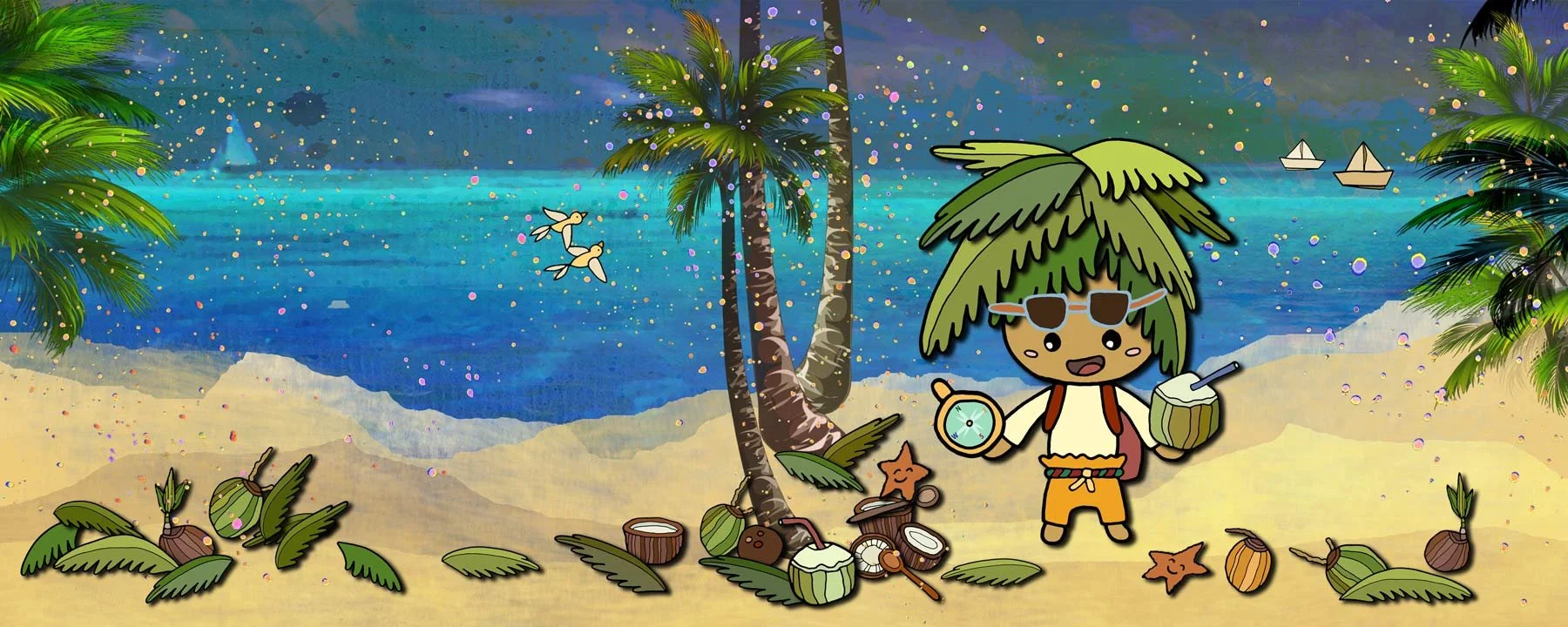Curious Coconut lives around the islands of Indonesia. A natural-born explorer, Curious Coconut likes to go on exotic adventures and learn about native habitats. Curious Coconut wears sunglasses to protect its eyes from the sun and carries a backpack filled with treasures. Curious Coconut always has a reliable compass for navigating the currents of the oceans and seas. Listening to music and drinking fresh coconut water are Curious Coconut’s favorite ways to relax – Coconut is laid back, confident and fun!
Curious Coconut planning another adventure!
Curious Coconut’s Family: The coconut palm, Cocos nucifera, is the only living species in the Cocos genus. The word coco is a 16th century Portuguese and Spanish word for “head” or “skull,” for the resemblance of the three indentations on the coconut shell to the face of a ghost. The word nucifera is a Latin word meaning “nut-bearing.” Coconut Palm trees can rise to heights of 100 ft tall. A mature coconut is about the size of a bowling ball. Each coconut has three layers: the outer layer is a smooth greenish shell called an exocarp, the second layer is a fibrous husk or mesocarp, and the third layer, called an endocarp, is a hard and woody husk. Beneath these is the “seed,” which contains a thick layer of edible white coconut “meat” and a drinkable liquid, often referred to as coconut water or juice.
Growing Climate: Tropical Islands
Botanical Lineage:
Species: Cocos nucifera (Coconut Palm)
Genus: Cocos (Coconut)
Family: Arecaceae (Palm tree family)
In India, the coconut palm tree is called kalpa vriksha, “the tree which provides all the necessities of life.” Many island nations view the Coconut Palm as the “Tree of Life.” Coconut Palms are believed to have originated in India 55-37 million years ago. They self-populated the tropical world by floating on ocean currents for up to 100 days or 3000 miles. Their journey would end when the husk reached fertile ground. There it could sprout and grow into a productive coconut palm within 6-10 years. Coconuts are an important and sustainable source of food, water, oil, fiber, wood and charcoal. Oils, butters and other important ingredients are extracted from coconut meat for culinary and personal care products. Coir comes from the fibrous husk of the coconut, and is used to make ropes, doormats, brushes and stuffing for mattresses. Palm fronds can be woven into baskets or used for thatched roofs. The interior husks can be turned into bowls and cups or painted as decorative art. Coconut trunks are used as a source of timber for small bridges, homes and furniture, as well as canoes and drums.
New Book Coming Soon!
Title: Curious Coconut – An Underwater Adventure
Storyline: Curious Coconut invites Truthful Tea Leaf and Blissful Bodhi on an underwater adventure to meet some of the curious sea creatures of Indonesia. When they arrive, Curious Coconut equips Truthful Tea Leaf and Blissful Bodhi with scuba diving equipment. The adventure begins when a sea turtle paddles by and a pair of colorful mandarin fish dart up to their goggles. The Forest Friends head toward a coral reef and notice a sunken treasure chest below. A manta ray glides overhead as they dive down to open the chest and out pops a friendly hermit crab. A herd of seahorses swim by as they see an Octopus on the ocean floor. An angelfish whispers in Coconut’s ear and clownfish float among the anemones. The friends follow a frog into a little stream filled with muddy water until they run into an underwater jungle. They climb up to discover a beautiful lotus garden. They take off their scuba gear to sit among the lotus flowers and enjoy the sunset.
Copyright © 2021 by Lanvi T. Nguyen and Laural V. Wauters.
All rights reserved.
